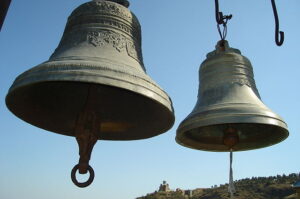By Professor Carol on Dec 19, 2014 03:00 am

Bells of St. Nicholas Church at Narikala, Tbilisi, Georgia
Bells! Now, here’s a beautiful (and serious) topic.
Bells are ancient. They are used virtually everywhere in the world. And they have played important roles throughout history, especially to sound alerts in times of danger. Plus, consider the mechanics and chemistry of casting bells – especially bells that weigh hundreds of pounds!
Let’s think primarily about bells in Christian worship.
Bells were the Christian Church’s first alarm clocks. Our modern word “clock” come from an Old Dutch word for bell – clocke (klok) (Old North French cloque and Medieval Latin clocca). The tolling of the bells was one way that people in earlier history could tell time. And “time” meant time for worship services!
As far back as Medieval France, a set pattern of bell-ringing would announce worship: for example, bells rang to mark the “hours” known as Matins (6.00 a.m.), Midi (12:00 noon), and Vespers (6.00 p.m). These are three of the eight (yes 8!) daily worship services known as Offices that were regularly observed in earlier Christian history (and are still observed by many).
Various regions promoted bells in different ways: Russian Christians (Eastern Orthodox) developed a huge love of church bells and called them “singing icons.” Russian bells ring in patterns, not specific melodies, and they had enormous influence on people’s devotional lives. You can hear actual zvons (bell sounds) here.
Bell-ringing is complicated, too. Here’s a good introduction to “change-ringing.”
Now, let’s think a bit smaller-scale. What about those beautiful polished handbells that are a favorite in so many churches?
Handbell choirs are always a big hit, and they offer a cross-generational opportunity to make music in worship. But they aren’t modern either. Handbells date far back, certainly to 5th-century Celtic missionaries, who placed them in religious buildings. Medieval illuminations (those pretty decorative pictures inside the capital letters in manuscripts) show chimes of handbells. Handbells also helped double the tenor line in choirs.
Finely tuned handbells such as the ones we hear today were developed around 1700. You can explore the anatomy of the modern handbell here and watch an accomplished group of ringers in this video:
Or, if you’re tastes run to something a little crazier, try this:
What about “jingle” bells? Here’s another practical bell, better named harness bells. In the centuries when horses were the primary way to move goods (and roads were dark and narrow), harness bells warned other travelers of an approach. In cases of trouble with a wagon, it’s said that bells would be given as a sign of appreciation for aid. To arrive with all harness bells in place meant the journey was safe – one possible origin for the phrase “I’ll be there with Bells on.”
This Advent season, encourage your children to explore bell sounds. Let bells punctuate their favorite poems and songs. Or, try using bells as a community time-keeper, perhaps regulating some of your household activities by the tinkling sounds.
One way or another, let those bells ring!
|
No comments:
Post a Comment